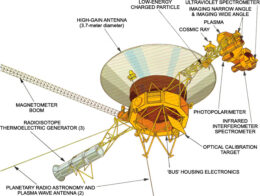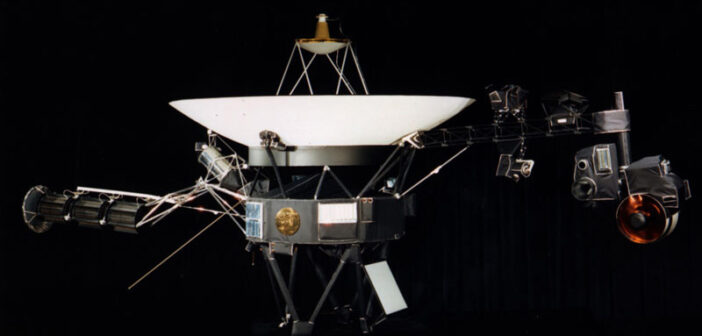How do cosmic rays spread through the galaxy? Historically, that’s been a hard question to answer from within the Sun’s protective bubble that shields us from some fraction of these high-energy particles. However, now that Voyager 1 has completed its hard-fought journey into interstellar space, astronomers can study cosmic rays beyond the reach of the Sun to build a fuller picture of the lives of these lightning-fast bits of matter.
Tiny Bullets

A schematic of Voyager 1. The cosmic ray experiments are in the upper right. [NASA’s Goddard Space Flight Center]
For about a decade, however, astronomers have been able to call upon a hardy scout that has flown beyond the reaches of our Sun and into the region where cosmic rays roam free. Voyager 1, launched an astounding 46 years ago and still limping along despite recent communication challenges, was the first human-made object to reach interstellar space back in 2012. Even as the spacecraft shut down other instruments to ration its limited power source, it kept its cosmic ray experiments powered up and collecting data. Now, by combining measurements from Voyager 1 with data collected by instruments on the International Space Station, astronomers can revisit their models of how cosmic rays move through the galaxy and within our solar system.

The Alpha Magnetic Spectrometer after its installation aboard the International Space Station. [NASA]
Many Models Mostly Working
Ethan Silver, University of California Berkeley, and Elena Orlando, University of Trieste, recently attempted this comparison. Using about a decade’s worth of data from Voyager 1 and from the Alpha Magnetic Spectrometer aboard the International Space Station, they were able to fit six different types of models of how cosmic rays move through the galaxy, each with many parameters that needed to be carefully tuned. Some of these models assumed that one can capture the behavior of cosmic rays using only a diffusion framework, while others were much more complex and allowed for numerous discontinuities in the input spectra of energies for each type of particle.
Silver and Orlando found that in general, all of the models they tested could explain the observed data with reasonable success. Though unsurprisingly the more complex models with more free parameters agreed with the measurements the best, the lighter-weight models held their own and couldn’t be confidently ruled out. Interestingly, all of the models tested failed on the same subset of observations: none of the schemes they tested, including the most complex diffusion-convection-reacceleration models, accurately predicted the flux of antiprotons with energies around ∼10 giga-electron volts. This missed prediction suggests that even with the help of probes far beyond our confines here on Earth, there is still much we don’t know about the production and transportation of cosmic rays. However, the general success of the models indicates that we’re on the right track, a validation enabled in large part by a distant and aging but well-loved spacecraft.
Citation
“Testing Cosmic-Ray Propagation Scenarios with AMS-02 and Voyager Data,” Ethan Silver and Elena Orlando 2024 ApJ 963 111. doi:10.3847/1538-4357/ad1ce8
